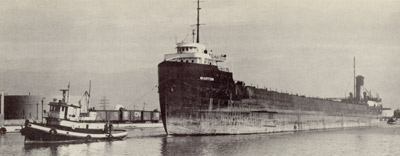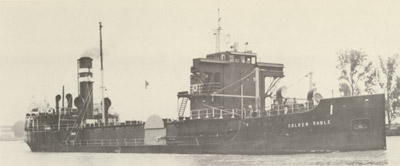Table of Contents
| Title Page | |
| Meetings | |
| The Editor's Notebook | |
| Marine News | |
| Salty Changes | |
| News from the Inland Rivers | |
| The Roller Boat | |
| Ship of the Month No. 16 Creek Transport | |
| Table of Illustrations |
In the mid-Summer issue, we reported that MAUNALOA II had been taken to the Hamilton yard of United Metals following her retirement from active service in June. As we had feared, the sale to United Metals was completed recently and, about the middle of October, cutting began on the stern of the old steamer. At last report, the work was progressing rapidly. You know, once in a while, on hearing of the demise of one of our old familiar vessels, your Editor finds himself immersed in daydreams. Presuming, of course, that a win in the Sweepstakes is imminent, he dreams of rushing out and buying the ship, operating her for what would undoubtedly be a short period of time, and going head over heels into bankruptcy, but enjoying every minute of it. This was one of those occasions......
Another Upper Lakes Shipping steamer which was idle this summer, WIARTON, was towed from Toronto's Ship Channel on October 8, 1971, by the tugs ARGUE MARTIN and JUDGE McCOMBS. She is currently lying at the Strathearne Street pier in Hamilton near MAUNALOA but we understand that she has not yet been sold by Upper Lakes, Due to her partially stripped condition, however, there can be little doubt that she will soon be cut up.

WIARTON leaves Toronto for the last time, October 8, 1971. Photo by the Editor.
We can now continue the story of the trials of the tanker GOLDEN SABLE, better known to locals as IMPERIAL CORNWALL. As of our last issue, we left her starting her new service into Lake Erie from the St. Lawrence, Unfortunately, it was found that her tanks were very badly deteriorated as she had been used by Imperial for many years as a "dirty" tanker, that is, she had been in the crude trade. Such a ship is not suitable for the "clean" trade, the carriage of gasoline or other highly refined products. In addition, government inspectors have apparently condemned her boilers. GOLDEN SABLE is currently laid up again at Montreal.
Another new tanker service that has run into difficulties is the Big D Line Ltd., operating out of Marine City, Michigan. Earlier in the summer, the company had placed their canal tanker ALFRED CYTACKI, formerly known as WESTERN SHELL, in service between the Shell plant at Corunna, Ontario, and the Detroit area, with motive power being supplied by the Port Colborne tug HERBERT A. For undisclosed reasons, the run has been discontinued and HERBERT A. brought the tanker back to Port Colborne where she now lies. The future is uncertain.

Shortly before being laid up, GOLDEN SABLE is seen upbound above W.S.C. Lock 1 August 25, 1971. Photo by Bill Bruce.
It has been announced that the self-unloader J. L. REISS, recently purchased by the Erie Sand Steamship Co. from the American Steamship Co., will be converted to oil fuel over the coining winter. The steamer has long been known for the large black cloud of coal smoke that habitually hung over her. Contrary to earlier indications, the purchase of the REISS will not spell the end for Erie's other large self-unloader SIDNEY E. SMITH JR., and next year should see both vessels proudly wearing Erie's green hull colours.
The Interlake Steamship Co., Pickands Mather and Co., has become the first American lake shipping firm to take advantage of the U. S. Maritime Administration's tax deferment plan. Under the scheme, companies may use moneys saved under the tax deferment to establish construction reserve funds, the money eventually being used to modernize their fleets through new construction or rebuilding. P.M.'s first project will be the lengthening of CHARLES M. BEEGHLY by approximately 96 feet. The steamer, built in 1959 and currently 690 feet in length, will enter Fraser Shipyards at Superior, Wisconsin, in early December. The work should be completed by next Spring. We understand that the company already has several other ambitious projects in mind.
Despite the enthusiastic plans of some operators, the decline in demand for iron ore has resulted in many more layups amongst American lake vessels. Heaviest hit has been U.S. Steel which has sent almost all of its older and smaller vessels to the wall in various ports. It appears that, before long, the company will only be operating those ships dating from the second war or later, plus those few older ships that have been repowered. Another fleet to suffer is Wilson Transit, many of whose ships are now surplus as a result of recent corporate changes. Other firms are sending their vessels to winter quarters as soon as their immediate cargo commitments are met.
Things remain hot in the Lake Erie area where certain residents along the Canadian shore are still battling for the cancellation of sandsucking licences as a result of shoreline erosion. The opponents of the dredging feel that it is the sole cause of erosion, an apparently erroneous conclusion. Meanwhile, the fate of CHARLES DICK and W. M. EDINGTON hangs in the balance.
A recent visitor to the American Shipbuilding Co. drydock at Toledo was IMPERIAL WINDSOR. She threw her wheel in Lake Erie in early October and had to be towed to port.
Construction is progressing on a new mainland ferry terminal at Toronto. Situated across the end of the pier on the west side of Yonge Street, the facility will be roughly on the site of Canada Steamship Lines' old passenger docks. Right next to the ferry slips will be a new marine fire terminal housing the fireboat WM. LYON MACKENZIE. Observers have been intrigued by the fact that the new ferry terminal will be able to handle only the existing vessels, and that no room for expansion has been allowed. The dock is expected to feature double-deck loading ramps, an installation not seen in these parts since the burning of the old Toronto Ferry Company's shed on March 13, 1918.
We understand that the Canadian Dredge and Dock Co., Ltd., will be continuing with its program of scrapping its old dredges and steam tugs at Hamilton to provide winter work for crews. MINNICOG and SHAWANAGA bit the dust last winter as well as other surplus equipment and it appears that such gems as the big steam tugs A. M. GERMAN and FRANK DIXON will soon reach the end of the road if the scrapping goes much further.
Confirmation has now been received that the tandem tow of STONEFAX and ALEXANDER LESLIE arrived at Santander, Spain, on June 19, 1971. This means that the only lakers currently waiting on our side of the Atlantic for the tow across are ONTADOC, CREEK TRANSPORT and GEORGE M. CARL, all three being laid up at Sorel. The latter vessel, the last coal-fired steamer in the Misener fleet, operated early in the year but was retired during the summer.
Reoch's self-unloader LEADALE recently made a rather unexpected visit to Port Huron, Michigan. At about 6:30 p.m. on Monday, October 18, while upbound with a cargo of salt for Alpena, she suffered a steering failure while opposite Pinegrove Park. The vessel grounded only a few feet out from the retaining wall and two Great Lakes Towing Co. tugs were sent to the scene. The steamer was pulled free early on Tuesday morning, but then the fun began. Just as LEADALE came free, the tug at her bow ran in the mud and was unable to pull the vessel's bow out from shore as planned. The current caught LEADALE and swept her downstream, narrowly missing the city's water intake plant and the Coast Guard Cutter BRAMBLE which was moored just below the park. Fortunately, there was no damage and the steamer was brought under control before anything more serious occurred.
Late summer saw the completion of one of the most unusual ships seen on the lakes in some years. Peterson Builders Inc., Sturgeon Bay, turned out the 243 foot aluminum-hulled oceanographic research vessel which was christened ALCOA SEAPROBE. Owned jointly by the Aluminum Co. of America and Ocean Science and Engineering, Washington, the ship passed down the Welland Canal in September. She was not built for lake service.
For the benefit of our high seas fans, we must report the sale for scrapping in Hong Kong of the former Polish liner BATORY, long a familiar visitor to Montreal harbour. Retired late in December, 1968, she has been used in the interim as an accommodation ship at Gdynia, Poland. BATORY was a motorship dating from 1935. Further bad news is that Hapag-Lloyd has decided to withdraw from the North Atlantic ferry. Its two liners, BREMEN and EUROPA, currently on the New York-Bremerhaven service, will come on the North Atlantic in 1972 and will henceforth be used in the cruise service, principally in American waters.
Previous Next
Return to Home Port or Toronto Marine Historical Society's Scanner
Reproduced for the Web with the permission of the Toronto Marine Historical Society.